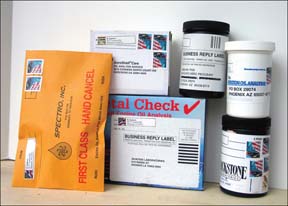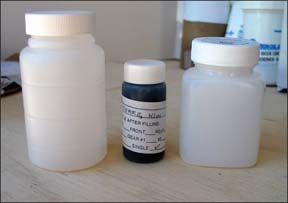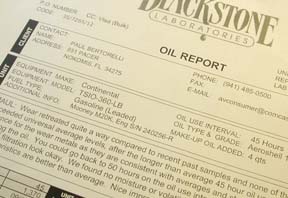
by Kim Santere
Engine oil analysis for light aircraft is widely-and cheaply-available, but is it really worth the bother? By all means, in our view. Although oil analysis wont work miracles, its so inexpensive and of such potential benefit that we think every owner should have an oil analysis program.
A number of labs offer this service so if the question isn’t whether to do analysis, its fair to ask which lab is best. To find out, we recently sent a dozen oil samples to six labs and compared the results, repeating an exercise we did six years ago.
The results were intriguing and, not too surprisingly, not particularly consistent. The big development is that some labs are using new technology to analyze samples which we believe will yield more accurate, consistent results, a definite plus. The best labs also report wear-metal trends and compare these to fleet trends established by in-house databases for the particular engine at hand. Our criteria were simple: For what were paying for analysis, how easy does the lab make it to pull and send a sample, how quickly do they burn it and interpret the data and how do they notify you?Simple.
Currently, there are no standardized procedures or equipment requirements for oil analysis. Spectrometers require libraries of elements as we’ll as frequent calibration, so operator technique as we’ll as the type of machine used all can affect the outcome. These factors enter into the varying results that we got from the same oil samples. It also illuminates the importance of trend watching for your specific engine. For example, Blackstone showed our iron to be abnormal at 161; AOA normal at 41.7; Exxgard normal at 54; Aeroshell abnormal at 334, Spectro abnormal at 132 and Aviation Labs, abnormal at 165.4.
Okay, We Cheated
Ever confident in the sanctity of modern analytical science, we carefully drained six samples from a mid-time Continental IO-360ES engine in a Cirrus SR20 and sent them off to the six labs. The Continental had suffered a prop strike and an insurance-mandated teardown some 150 hours earlier. The tow bar had been left connected and you know the rest.
Since this was a random engine selection, there was no previous track record of oil analysis for this engine. We would reasonably expect to obtain similar findings from each lab. No surprise that we did not.
Also, as it did six years ago, our sampling test included a slight chain of custody problem. A second set of samples we sent to the labs contained oil from our infrequently flown 1994 Chevy V-8 pickup truck. We wanted to see if this obviously bogus sample would set off any alarms. Would the labs detect the difference between Pennzoil and AeroShell 15W50? All of them suspected the ruse but only two called us for more details.
We chose labs that we either know about or which advertise prominently in the aviation world. These include Blackstone Labs of Fort Wayne, Indiana, Aviation Oil Analysis in Phoenix (marketed through Aircraft Spruce and other catalogs), Aeroshell Oil Analysis (Analysts Inc.) from Shells Web commerce site, Spectro, Inc. of Arlington, Texas and Wearguard (Aviation Laboratories) in Kenner, Louisiana with kits sold by Chief Aircraft and other catalogs.
We discovered that Aviation Oil Analysis (AOA) is also a subcontractor to Exxon, where we purchased our analysis kit from the Exxon Exxgard oil analysis Web site. Further, AOA and Exxgard are operated by Stavely Services, so the same person and machine will do your sample whether you send it to Exxon or AOA.
Methodologies
Some notes on price, sales and sample methods: The general standard in the industry is pre-payment for a sample bottle, mailing container and data form, with the pre-pay covering the cost of the analysis. Some have postage prepaid, others don’t. When you add up shipping expenses-both ways in some cases-the lowest total costs change. Chasing stamps for containers was a pain, but only three labs have a prepaid set-up. (See the chart above more.)Spectro was a model of efficiency. The sample bottle was so small that only two stamps were needed. They were also on the ball for a quick set of bottles on request. We also received the results the fastest. The Blackstone bottle, on the other hand, was gigantic, holding up to five ounces.
As shown in the chart, prices for these kits vary between $14 and $21.59 when the full roundtrip postage is factored into the kit cost. Blackstone and Spectro were the only mail order sources that will send you the sampling kit for free, then expect payment by check or credit card when the oil arrives for analysis.
All include a self-mailer of some kind, either an envelope or box or, in the case of AOA, Exxon and Blackstone, a bottle within a bottle, with the larger bottle serving as the shipping container. Interestingly, the small boxes were easier to use than the plastic containers to stuff paperwork into.
One thing we think is important to avoid errors is that the sample bottle have its own label, identifying at least the aircraft N-number, if not the engine serial number. Spectro, Aviation Labs and AeroShell had this, but if any oil gets on the container, forget making a label stick to it. For us, self-stick home address labels worked better than anything else.

AeroShell Care and Exxgard market via e-commerce. Point, click and ship and five days later, the kit arrives in your mailbox-maybe. The AeroShell set-up was awkward, in our view. After you place your order, no credit card information request shows on the Web site. Instead, someone calls a few hours later for a card number with the explanation that buyers don’t like giving card info over the Web. Really? This is news to us. Although arguably more secure, this introduced human error: The order taker reversed two card numbers, causing several additional days of delay in getting the kits.
With respect to abnormal readings, apparently the degree of abnormality determines whether a phone, fax or normal mail notification is used by the lab. In our case, Aviation Labs deemed high iron sufficient grounds for a fax notification, where none of the other labs which found high iron felt it was worth extraordinary notification. All of the labs pledge to turn the samples around within a day or two and our mail notice from Spectro arrived at the same time as the fax notice from Aviation Labs. If you have any specific concern about a sample, request phone or fax or e-mail notification ahead of time.
Several of the labs offer additional services. AOA, AeroShell and Exxon offer the availability of on-line results posted after the sample is processed. You need to sign up for these services on the Web site. They have software that allows for some data manipulation and information sharing. This would be a valuable service if multiple people are involved in the maintenance of an airplane or fleet.
Sampling Errors
Sampling anomalies are unrecognized as a problem, yet these are far more influential than many realize. Before taking a sample, its best that the oil be warmed up and the sample be taken at mid-drain after a few quarts have flowed out. Additionally, if a quick drain is used, it must be clean to avoid contaminants washing into the sample.
Use a clean hose to catch the sample, not a dirty one in a bucket with unknown previous contamination. Also, keep track of any make-up oil, since this directly affects the concentrations of any contaminant findings.Moreover, if you don’t use the same oil for the make-up quarts, note that fact so the lab will be aware of different additive packages that may influence its findings. Take the sample directly into the sample bottle. don’t dip the bottle into the oil bucket. Even excess DC-4 from a filter gasket can cause the oil to show excess silicon if the DC-4 gets into the oil.
Of course, our pick up truck ruse intentionally introduced a massive sampling error. Would anyone catch it? We got a call from Sam Villegas at Aviation Oil Analysis, who asked for more information on the erstwhile Continental O-200 (truck V-8) sample we sent. He said the instant he saw it, it smelled wrong and the viscosity wasnt right. Hats off to a sharp nose.Four other labs passed it right through. A second call on our bogus sample came from John Vicari at Aviation Labs, who said the elemental breakdown just wasnt making sense. Another good catch. While we laud the labs who caught on to our dirty trick, we think other factors are more critical in picking a lab, such as the labs report and interpretation of data.
Results
Analytical results were all over the map. Unfortunately, they varied wildly on the critical wear item: iron. Four labs said abnormal, two said normal. Aviation labs faxed the results because of the abnormality and advised us to contact the engine service rep.
The four labs which did find abnormal iron were relatively close in their findings, as were the two labs showing normal readings. For something as basic as iron, we were initially puzzled to see these results, considering how careful we were in sample handling.
After some calls to the labs, it turns out that the labs that found the abnormality use ICP (inductive coupled plasma) technology spectrometers, the current gold standard. The two normal readings came from the same source, Stavely Services, which handle Exxon and AOA customers. Stavely uses atomic absorption spectrometers, which are not considered to be as sensitive as ICP machines. In oil analysis work, trends are the important thing and while both methods would track trends, for sheer accuracy, ICP is the better way, according to our results and interviews with experts.

Our favorite lab, Blackstone, provides a universal guideline comparison column so you have an idea of where your sample falls. For example, is 160 PPM really bad for iron? Other labs simply tag it as above normal, but with Blackstone, you see its four times normal by their standards. These norms have been developed through 20 years of data crunching for engines of a type similar to the engine being examined. We consider this valuable and its unique to Blackstone.
Blackstone also provides a full paragraph of narrative interpretation on the findings. Of course, the language is somewhat general, but its a place for the shop to start an investigation, if warranted. Blackstone also has an extensive Web site with useful information and it can provide additional individualized testing services.
The other labs essentially provide a list of abbreviations for elements and codes at the end of the page if something is out of range. Some labs make a few terse comments, but are so general in nature as to be of minimal value.We think there’s merit in showing oil and fuel dilution and Blackstone and AeroShell do this. Blackstone and AeroShell measure 20 variables, where the others show about 10. But the bulk of wear-metal problems are found in four or five categories, which all the labs cover.
We could dissect each lab further, but Blackstone was such a standout in terms of turnaround time and a superbly lucid report that we pick it as the top lab. You pay more for Blackstones services, but you also get more and for $15 or $20 price Delta a year, the difference is pocket change. Our second choice is Spectro, a small lab that provides quick, efficient service.
Last, a word about filter cutting. Fatigue wear, such as cam spalling, isn’t found by oil analysis so you have to dissect the filter and inspect it for metal. The practical limit in oil analysis is detecting particles down to 10 microns. But its the larger particles that cause the most wear, so filter and screen inspection are a must and are complimentary of oil analysis, not duplicative. Both methods require watching trends, although a filter with a quarter teaspoon of metal calls for immediate diagnosis, not monitoring.
With this in mind, one-shot oil analysis is largely unhelpful in making any maintenance decisions, notwithstanding wildly disparate readings which might necessitate further investigation, such as spiked silicon indicating a leaking air cleaner. Trend watching with the same lab is where the benefits of analysis lie.
Also With This Article
“Checklist”
“Burning Oil: How It Works”
“Oil Lab Prices and Services Compared”
-Kim Santerre is editor of Aviation Consumers sister magazine, Light Plane Maintenance.





